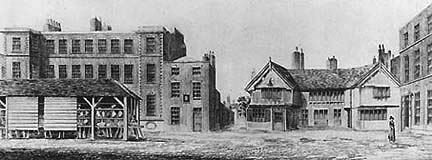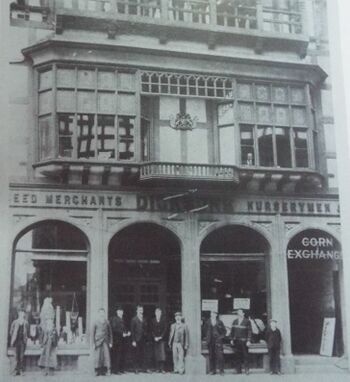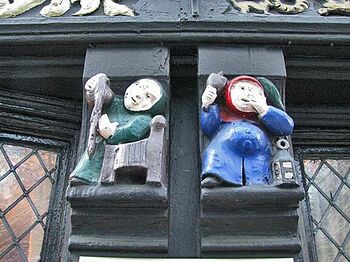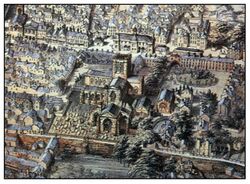Shambles
Guidebooks to Manchester inform us that the black and white timber Shakespeare pub has an intriguing place in Manchester's history - but while the building itself dates back to 1656, it did not take up home in the city until centuries later. Somwhat mysteriously, the signage at the pub says that the pub started life as The Shambles pub in Chester in the 17th century, and that in 1928 it was dismantled, transported 40 miles to Manchester, and re-erected in its current location (together with resident ghost).
That seems a very unlikely tale and a little research reveals that the building was created in 1923 by W. Johnson and Sons and much of it is mock timber framing. However, some of the carvings and other ornamentations came from a building that was demolished in Chester and are probably 17th Century. The puzzle is - whereabouts in Chester was the building taken down in 1923 or shortly thereafter?
Chester did have its own "Shakespeare" pub, on Foregate Street, but there is nothing to suggest that this pub was moved to Manchester. It also had a "Shambles" but this was not a pub and any 17th Century parts of this appear to have mostly gone long before the 1920's.
Moving a building
It is possible to "move" a building and with half-timbered structures it has been done quite often.
One local examples was the translocation of Dutton Hall from near Chester to East Grinstead in Sussex. The original hall was built around 1150 by Sir Geoffrey de Dutton and at one time formed part of a larger quadrangular structure. It was subsequently rebuilt several times following its partial destruction by warfare. John Arthur ("Lucky") Dewar had inherited the wealth of the whisky family in 1930, and one day some two years later Mrs. Dewar was in a London bookshop when she came across The Duttons of Dutton, an anonymously written account of the Cheshire family, published in 1901. So fascinated was she by the photographs of Dutton Hall which the book contained that the idea of buying the property and re-building it in Sussex came to mind. At this time Dutton Hall had been for many years a farmhouse and only the east side of the original quadrangle and the great hall remained of Sir Piers and Dame Julian’s house. The Dewars visited Cheshire and found that they could buy the Hall and take it away, provided that a new farmhouse was put up in its place. So it was agreed. Under the supervision of Mr. Wood, an expert from Bath, Dutton Hall was carefully taken to pieces, all the stones and beams were marked and numbered and moved by steam wagon to Sussex, and there re-erected by 1933.
There had been a similar proposal in 1866 to dismantle Stanley Palace on Watergate Street and rebuild it in America, fortunately the Earl of Derby bought the building to save it.
Other moves went ahead - Agecroft Hall is a Tudor manor house in a neighborhood of Richmond, Virginia, United States. The manor house was built in the late 15th century, and was originally located in the Irwell Valley at Agecroft, Pendlebury, then in the historic county of Lancashire, England, but by the 20th century it was unoccupied and in a state of disrepair. The manor house was dismantled, crated, transported across the Atlantic, and reconstructed. The project was completed during the spring of 1928.
In more recent times "authentic" half-timbered buildings have been moved around Manchester. The Old Wellington Inn is now in "Shambles Square" but has been dismantled and moved 300 metres. However even cursory inspection reveals that "The Shakespeare" is mostly a 19th century example of "mock Tudor".

So if the entire building was not moved from Chester then what about some small decorative parts such as the carved wooden figures on the front? There are similar carved figures on Shoemakers Row in Northgate Street at Chester, but those date from the early 1900's and differ in style. The rest of this article looks at whether parts of the "shambles" in Chester could have survived an eventually been translocated to Manchester.
The Chester Butcher's Shambles
"Shambles" was a name originally used for a street of butchers shops where meat was slaughtered and sold. It is derived from the Middle English word schamel, which meant a bench, as for displaying meat for sale. A shambles would have had blood, pieces of meat and offal running down the gutter, and although the original meaning of the word fell into disuse, it survived as a word meaning a scene of disorder. There are a few pubs dotted around the country named "The Shambles" (one in York for example) but searches have not revealed that any pub or inn of that name ever existed in Chester.
In Chester the by the late 12th century the main focus of the market lay south and east of St. Peter's in the broad space forming the northern end of Bridge Street and the westernmost part of Eastgate Street. The area was called a forum in the early 12th century, when it seems to have been fronted by shops and important houses. Later it contained the pillory and the High Cross. The original market place evidently incorporated the northwestern corner of Eastgate Street opposite St. Peter's, in the 11th century apparently an open space surfaced with extremely worn Roman tiles. By the 13th century that site was occupied by the Buttershops, a permanent structure which perhaps superseded temporary stalls. Dairy stuffs were sold there in the early 14th century, and by the later 15th it was associated with the milk stoups, iron vessels from which milk was sold. Marketing also seems to have extended west from St. Peter's along Watergate Street, where by the mid 14th century the fish market, also called the Fishboards, was located at the eastern end on the south side, while on the north side next to the church lay the butchers' shambles. The Assembly established a new shambles underneath the common hall (St Nicolas Chapel) in 1578,
By the 1530s, the great hall at Chester Castle was in ruins, and between 1577 and 1582 it was almost completely rebuilt at a cost of £650 to house the shire Courts, the Castle having become the base for the County justices 1536. At this time the "parliament chamber", immediately south of the great hall, was reconditioned to accommodate the exchequer court. The "Saxon" Great Hall (it was almost certainly Norman) in the outer bailey stood roughly where the court buildings now stand. However, the "Saxon" hall was not demolished - in 1581, the city magistrates bought it "for six Cheshire cheeses", and moved it to the Market Square where it served as a granary, before being taken over by the city's butchers, to become the "flesh shambles".
The city butchers were frequently in trouble for bad meat and high prices. In 1578 the Assembly therefore opened a new flesh shambles for country butchers, and kept it open in the face of persistent hostility from the city butchers. The Braun and Hogenberg map of Chester from 1581 shows a building in the Market Square (now the Town Hall square) and this is presumably the "Shambles".
Market Square chemist and amateur historian Shrubsole, writing in the annals of the Chester Archeoligical Society & Historic Society describes the transaction as follows:
- "The citizens obtained from the Queen a grant of the Old Shire Hall it belonged to the county here the forces of the Earls of Chester, or the Sovereign in later times would have summoned to meet and find accommodation for their horse and foot soldiers it was used as a supplement to the resources of the castle. Finding themselves short of a market building the city authorities cast longing eyes at the old building which they considered no longer required for its original purpose. The Mayor opened a correspondence with Lord Burleigh on the subject as to a free grant of the same building as it was for the use of the citizens. The Treasury were not in the mood for to give but would sell for £40 . The Mayor in forwarding the money, with thanks to the Lord Treasurer, said that although the Corporation could not gratify his Lordship as they ought, yet they presumed to send half a dozen cheeses . It was erected in Northgate Street, opposite the Abbey Gate , and mainly used as a shambles by the butchers."
The shambles thereafter remained in Northgate Street, but it was rehoused in 1695 in a new building, which by 1728 accommodated both city and country butchers, large numbers of the latter attending on Wednesdays and Fridays. During the 1690s the Butchers' company tried to monopolize the cheaper standings at the new flesh shambles and seized meat sold by country butchers, though by the 1720s the country butchers' right to trade was established: after a brief spell in the Northgate gaol members of the Butchers' company who were thus forced to acquiesce. At this time the rent of the flesh shambles each usually brought in at least £100 for the Corporation. In 1734 it was joined by the fish market, moved from the site of the medieval Fishboards in Watergate Street. We also hear of a possible shambles from the 1575 records which mention the "House of Correction":
- "This year there was a collection made in the city and of some worshipful in the county for a stock to set the poor on work and a house of correction built under the city wall near unto the Northgate which house was removed out of the corn market and was first placed there by Mr Webster for the butchers of the city."
In a watercolour by Moses Griffiths (1747-1819), the "House of Correction" is placed on the northern bank of the canal - but this looks nothing likw the "old Saxon Hall". It is said that this was pulled down by the city's defenders during the Civil War siege, together with almost everything else outside the City Walls, but was replaced in 1655–7 by a new house of correction on the same site. Initially intended to provide corrective employment for the able-bodied destitute in tasks such as weaving cloth, it came, like similar establishments elsewhere, to be used as a prison for minor offenders convicted by the magistrates. In the 1770s a workshop and two 'dungeons' were added. It was closed in 1808 and sold in 1817 to Joseph Fletcher, who converted the buildings into dwellings known as Northgate Terrace.
The corporation records also list:
- Bond in pursuance of an order of the Assembly to Sir John Mainwaring of Peover, bart., in trust for the repayment of £200 without interest by 25 Mar. 1696 to Roger Whitley, then mayor, who lent it to the city for completing payment for the new butcher's shambles.
The shambles turns up again in connection with Flookersbrook field and an investigation by the Charity Commissoners for Chester in their "Report of the Commissioners sent to Chester to enquire into the Charities of the City" (published by John Monk in 1829). In this there is a reference to "the new markets (the present Shambles, about 1828)". It was at this time that, on the initiative of the mayor, Henry Bowers, a new shambles with an adjoining market house for butter was erected north of the Exchange, and a new fish and vegetable market to the south.
From the above it is clear that the "Shambles" in Chester was rebuilt several times. It could at some point have been adorned with carvings such as the ones now in Manchester, but none of the very few depictions of the Shambles at Chester indicate that any such existed. The only circumstantial evidence is that carvings of a similar but not identical nature were later used by Edwardian architects on the corner of Market Square and this could have been a reference to older ones elsewhere in the square. However, none of the various writers of guidebooks on Chester from the relevant period mention any older carvings and are often dismissive of the Shambles as being a without any merit.

Another possibility is that the reference is actually meant to refer to an Inn at or near the Shambles. There were certainly plenty of these and many were of some antiquity. Some were coaching inns of some standing and others were associated with the market trade. As well as the pubs there were also a number of other half-timbered buildings facing onto the square which have since been lost.
The Corn Market & Exchange
Yet another possibility for the source building is one of those associated with the trade in corn. This seems have had a close association with the Butcher's Shambles and some of the various incarnations of the corn market also appear to have moved about at times.
Said to be housed in a new building on the west side of Northgate Street in 1556, it was moved to the east side by the bishop's palace in 1574 but after protests from the chapter the building was dismantled in 1576 and reused as the house of correction. A new corn market was erected on the site, but by 1651 had moved further north near Little Abbey Gate. In the earlier 17th century the city remained strongly protectionist towards the corn trade, prohibiting private sales from inns or cellars in 1615, and granting the serjeants-at-mace control of measuring grain sold in open market in the 1620s.
After the Exchange was built in the 1690s the corn market was resited on its northern side, north of the butchers' shambles, but by then the open market in grain was in severe decline. In 1859 a corn exchange was built by seedsman George Chivas on the site of Manchester Hall off Eastgate Street, which had previously been used for cloth goods. Built of red sandstone and Gothic in style, the building included a large top-lit hall entered through a long passage from Eastgate Street, and a range of offices facing the cathedral graveyard, with access from the city walls. It was managed by a committee of ten subscribers and two representatives of the city council and had space for 40 stands; the weekly Saturday corn market lasted until the early 20th century. The building itself, which from the beginning was also used for public meetings, lectures, and exhibitions, as well it seems as the Corn Exchange Cinema. The frontage to Eastgate Street (Number 37) was rebuilt 1892 by Charles A. Ewing for Messrs Dickson. That business survived until the 1920s but by 1928 had been replaced by a branch of Woolworth's.
It is possible that the movement of the corn-market from the Shambles to the former Manchester Hall and it's later use as a cinema could have enabled the survival of some 17th Century carvings, but again, there is no evidence for this.
So where did the carvings come from?
There was never a pub in Chester officially named "The Shambles" and the story that it was moved wholesale from Chester to Manchester where it became "The Shakespeare" is clearly a myth. There may have been some carvings taken from Chester that were in some way associated with the former "Butcher's Shambles" but no evidence has been found as to how this happened or where these carvings were located in Chester.
Sources and Links
Related Pages
- Chester Market;
- Dutton: and the removal of Dutton Hall;




